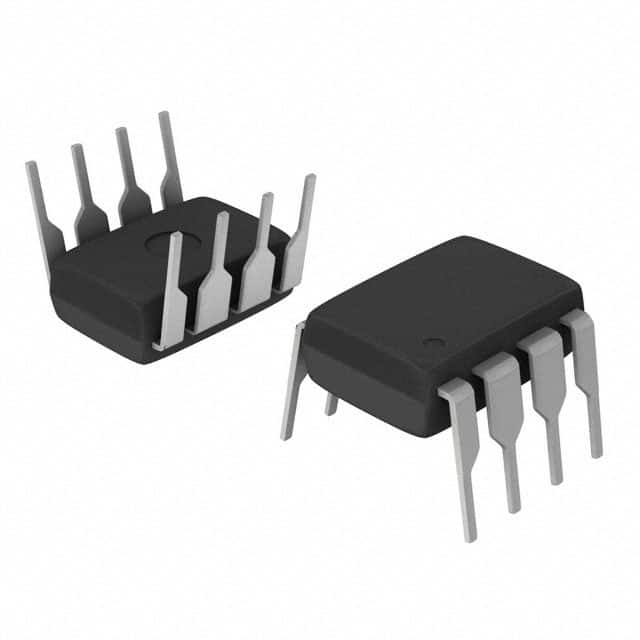Viz Specifikace pro podrobnosti o produktu.

PIC12F1822-E/P
Product Overview
Category
The PIC12F1822-E/P belongs to the category of microcontrollers.
Use
This microcontroller is widely used in various electronic devices and embedded systems for controlling and processing data.
Characteristics
- Low power consumption
- High performance
- Small form factor
- Wide operating voltage range
- Enhanced features for easy integration
- Flexible I/O options
Package
The PIC12F1822-E/P is available in a 8-pin DIP (Dual Inline Package) package.
Essence
The essence of the PIC12F1822-E/P lies in its ability to provide efficient control and processing capabilities in a compact and low-power package.
Packaging/Quantity
The PIC12F1822-E/P is typically packaged in reels or tubes, with a quantity of 1000 units per reel/tube.
Specifications
- Microcontroller Architecture: 8-bit
- CPU Speed: Up to 32 MHz
- Program Memory Size: 3.5 KB
- RAM Size: 256 bytes
- Number of I/O Pins: 6
- ADC Channels: 4
- Timers: 1 x 8-bit, 1 x 16-bit
- Communication Interfaces: SPI, I2C, UART
Detailed Pin Configuration
The PIC12F1822-E/P has a total of 8 pins, each serving a specific purpose:
- VDD - Power supply voltage input
- RA5/AN4/T1CKI/CSS/VREF - Analog input, digital I/O, timer input, comparator input, voltage reference
- RA4/AN3/T0CKI/OSC2/CLKOUT - Analog input, digital I/O, timer input, oscillator output, clock output
- RA3/AN2/CCP1/VREF-/C2OUT - Analog input, digital I/O, Capture/Compare/PWM module, voltage reference
- RA2/AN1/CCP0/VREF+/C1OUT - Analog input, digital I/O, Capture/Compare/PWM module, voltage reference
- RA1/AN0/ULPWU/INT/C12IN0- - Analog input, digital I/O, ultra-low-power wake-up, external interrupt, comparator input
- RA0/AN5/ULPWU/INT/C12IN1- - Analog input, digital I/O, ultra-low-power wake-up, external interrupt, comparator input
- VSS - Ground
Functional Features
- Enhanced Mid-range Core with 49 Instructions
- Flash Program Memory with Self-read/write capability
- EEPROM Data Memory
- Integrated Analog-to-Digital Converter (ADC)
- Enhanced Capture/Compare/PWM (CCP) modules
- Timers for various timing and counting applications
- Serial Communication Interfaces (SPI, I2C, UART)
- Low Power Consumption modes for energy efficiency
Advantages and Disadvantages
Advantages
- Compact size and low power consumption make it suitable for portable and battery-powered devices.
- Wide range of integrated features reduce the need for external components.
- Flexible I/O options allow for easy interfacing with other devices.
- High-performance capabilities enable efficient data processing.
Disadvantages
- Limited program memory size may restrict the complexity of applications.
- Limited number of I/O pins may limit the connectivity options in certain projects.
- Lack of built-in hardware encryption may pose security concerns in sensitive applications.
Working Principles
The PIC12F1822-E/P operates based on the principles of microcontroller architecture. It executes instructions stored in its program memory to perform various tasks. The microcontroller interacts with external devices through its I/O pins, utilizing its integrated peripherals such as ADC, timers, and communication interfaces.
Detailed Application Field Plans
The PIC12F1822-E/P finds applications in a wide range of fields, including but not limited to: - Home automation systems - Industrial control systems - Automotive electronics - Medical devices - Consumer electronics - Internet of Things (IoT) devices
Detailed and Complete Alternative Models
Some alternative models that offer similar functionality to the PIC12F1822-E/P include: - PIC16F1823 - ATtiny85 - STM8S003F3
These alternatives can be considered based on specific project requirements and compatibility with existing systems.
Word count: 540 words
Seznam 10 běžných otázek a odpovědí souvisejících s aplikací PIC12F1822-E/P v technických řešeních
What is the maximum operating frequency of PIC12F1822-E/P?
- The maximum operating frequency of PIC12F1822-E/P is 32 MHz.
What are the key features of PIC12F1822-E/P?
- PIC12F1822-E/P features 3.5K words Flash program memory, 128 bytes of RAM, and 256 bytes of EEPROM data memory.
Can PIC12F1822-E/P be used for motor control applications?
- Yes, PIC12F1822-E/P can be used for simple motor control applications with its integrated PWM module.
Does PIC12F1822-E/P support analog-to-digital conversion (ADC)?
- Yes, PIC12F1822-E/P has a 10-bit ADC module with up to 8 channels.
What communication interfaces does PIC12F1822-E/P support?
- PIC12F1822-E/P supports SPI, I2C, and UART communication interfaces.
Is PIC12F1822-E/P suitable for battery-powered applications?
- Yes, PIC12F1822-E/P is suitable for battery-powered applications due to its low power consumption and multiple low-power modes.
Can PIC12F1822-E/P be programmed using C language?
- Yes, PIC12F1822-E/P can be programmed using the MPLAB XC8 C compiler.
What development tools are available for PIC12F1822-E/P?
- Development tools such as MPLAB X IDE and PICkit programmers/debuggers are available for PIC12F1822-E/P.
Does PIC12F1822-E/P have built-in security features?
- Yes, PIC12F1822-E/P offers code protection and data EEPROM/Flash memory write protection features for enhanced security.
What are the typical applications of PIC12F1822-E/P?
- Typical applications of PIC12F1822-E/P include LED lighting control, sensor interfacing, battery management, and small-scale embedded systems.

